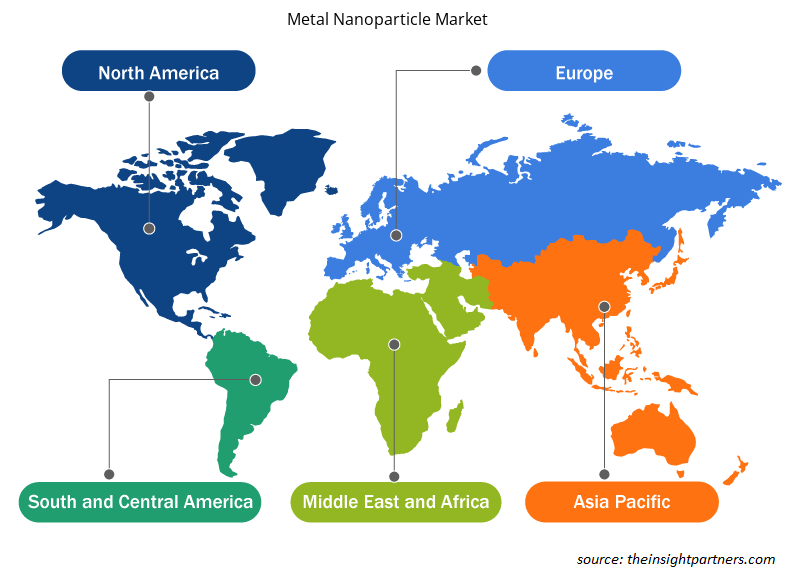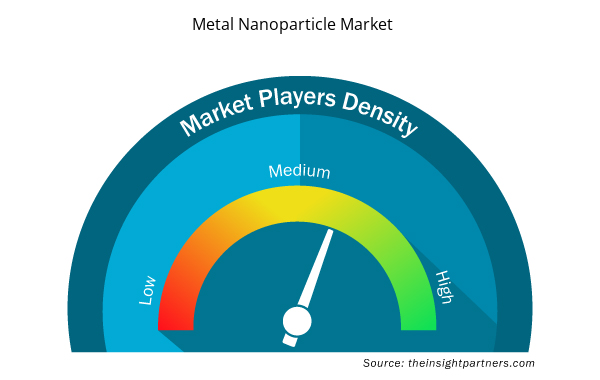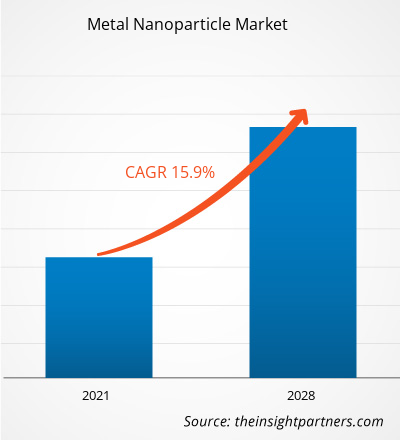[研究报告] 2020 年金属纳米颗粒市场价值为 253.7392 亿美元,预计到 2028 年将达到 815.6738 亿美元;预计 2021 年至 2028 年的复合年增长率为 15.9%。
金属纳米粒子具有高纵横比和均匀尺寸等优异特性。它们被广泛应用于催化、医疗和储能等各种领域。金属纳米粒子在制药和医疗保健、化学、化妆品以及电气和电子产品等终端行业有多种应用。
2020 年,北美占据了最大的市场份额。制药和医疗保健行业的发展以及对可持续能源资源的需求增加,增加了北美对金属纳米颗粒的需求。由于美国和加拿大等发达国家的存在,以及政府对研发活动的有利支持,该地区的国家探索和生产创新产品。此外,医疗技术的进步和医疗保健行业投资的增加推动了医疗行业对金属纳米颗粒的需求。除此之外,国内外金属纳米颗粒公司在该地区的存在为该地区的金属纳米颗粒市场创造了丰厚的机会。
持续的 COVID-19 疫情对金属纳米颗粒市场产生了重大影响。疫情导致国家和国际边界突然关闭,从而扭曲了运营效率并扰乱了价值链,造成了收入损失和损害。生产和供应链中断对金属纳米颗粒市场产生了负面影响。各国实施封锁以及旅行限制,减少了全球产品供应,并减少了物流运营。人们一直在研究将金纳米颗粒用于 COVID-19 检测试剂盒,该试剂盒将在几分钟内提供结果。在美国,马里兰大学的一组研究人员声称,他们已经开发出一种诊断测试,可以在 10 分钟内检测到导致 COVID-19 的新型冠状病毒,结果将肉眼可见。该测试是一种简单的基于比色法的检测方法,它使用覆盖有 SARS-COV-2 病毒核衣壳磷蛋白核酸序列的金纳米颗粒。与此同时,韩国 Sugentech 公司开发了 SGTi-flex COVID-19 IgM/IgG 检测试剂盒,这是一种基于金纳米颗粒的免疫色谱检测试剂盒,可测定 COVID-19 的 IgM 和 IgG 抗体。该检测有助于确定抗体,即针对感染而产生的特定蛋白质。因此,医疗保健领域金纳米颗粒使用量的增加对金属纳米颗粒市场产生了积极影响。
定制此报告以满足您的需求
您可以免费定制任何报告,包括本报告的部分内容、国家级分析、Excel 数据包,以及为初创企业和大学提供优惠和折扣
- 获取此报告的关键市场趋势。这个免费样品将包括数据分析,从市场趋势到估计和预测。
市场洞察
金属纳米粒子在医疗行业的应用
在医疗行业,金属纳米粒子越来越多地用于治疗剂、药物输送、生物成像、癌症诊断和治疗等应用。各种类型的金属纳米粒子,包括银、钛、金、铂和铜,都因其潜在的治疗效果而闻名。金和银纳米粒子可有效抑制革兰氏阴性菌和革兰氏阳性菌的生长。金纳米粒子用于检测传染病、癌症和心脏病诊断中的生物标志物。铂纳米粒子因其固有的抗菌、抗氧化和抗癌特性而用于植入物、成像、光热疗法和药物输送等生物医学应用。钛纳米粒子被用于杀死各种表面上的细菌。当暴露于紫外线时,这些纳米粒子会产生强烈的氧化作用并充当光催化消毒剂。银纳米粒子具有抗菌和抗癌特性,它们越来越多地用于伤口涂层和设备涂层的生产。铜纳米粒子在医疗领域用于预防、控制和治疗感染。因此,各种金属纳米粒子在医疗行业的应用激增,推动了金属纳米粒子市场的发展。
金属洞察
根据金属,金属纳米颗粒市场细分为铂、金、银、铁、钛和其他。2020 年,其他细分市场占据了市场主导地位。其他金属纳米颗粒由锌、铜、二氧化硅、锰、铝、镍、铈和铊等金属制成。锌纳米颗粒是一种无机金属氧化物,可安全用于药物、包装防腐剂和抗菌剂。锌纳米颗粒很容易扩散到食物材料中并杀死微生物。铜纳米颗粒是通过自然过程或化学合成产生的。它们越来越多地用作着色剂和抗菌剂。二氧化硅纳米颗粒主要用于电绝缘体和热绝缘体以及药物输送应用。锰纳米粒子(纳米点或纳米粉末)是球形或多面高表面积金属纳米结构粒子。铝纳米粒子具有更大的储氢容量,广泛用于飞机、军事应用、汽车和火箭推进剂。
金属纳米粒子市场的一些主要市场参与者包括 American Elements;BBI Group;EPRUI Biotech Co. Ltd.;Meliorum Technologies, Inc.;Nanocomposix;Nanosc, Inc.;Nanostructured and Amorphous Materials, Inc.;Nanoshel LLC.;TANAKA HOLDINGS Co., Ltd.;和 US Research Nanomaterials INC. 市场的主要参与者采用并购和产品发布等策略来扩大地理覆盖范围和消费者基础。
报告亮点
- 金属纳米颗粒行业的进步趋势有助于参与者制定有效的长期战略
- 公司采用的业务增长战略来确保发达市场和发展中市场的增长
- 2019 年至 2028 年全球金属纳米颗粒市场定量分析
- 各行业对金属纳米颗粒的需求估计
- 波特分析说明了行业内买家和供应商预测市场增长的有效性
- 了解竞争激烈的市场形势和对金属纳米颗粒的需求的最新发展
- 市场趋势和前景以及推动和抑制金属纳米颗粒市场增长的因素
- 了解全球金属纳米颗粒市场增长的商业利益背后的战略,有助于决策过程
- 金属纳米颗粒市场在各个市场节点的规模
- 全球金属纳米颗粒市场的详细概述和细分以及其行业动态
- 金属纳米颗粒市场规模在各地区均具有良好的增长机会
金属纳米粒子
金属纳米颗粒市场区域洞察
Insight Partners 的分析师已详细解释了预测期内影响金属纳米颗粒市场的区域趋势和因素。本节还讨论了北美、欧洲、亚太地区、中东和非洲以及南美和中美洲的金属纳米颗粒市场细分和地理位置。

- 获取金属纳米颗粒市场的区域特定数据
金属纳米颗粒市场报告范围
| 报告属性 | 细节 |
|---|---|
| 2020 年市场规模 | 253.7亿美元 |
| 2028 年市场规模 | 815.7亿美元 |
| 全球复合年增长率(2020 - 2028) | 15.9% |
| 史料 | 2018-2019 |
| 预测期 | 2021-2028 |
| 涵盖的领域 | 按金属分类
|
| 覆盖地区和国家 | 北美
|
| 市场领导者和主要公司简介 |
|
金属纳米颗粒市场参与者密度:了解其对业务动态的影响
金属纳米颗粒市场正在快速增长,这得益于终端用户需求的不断增长,这些需求源于消费者偏好的不断变化、技术进步以及对产品优势的认识不断提高等因素。随着需求的增加,企业正在扩大其产品范围,进行创新以满足消费者的需求,并利用新兴趋势,从而进一步推动市场增长。
市场参与者密度是指在特定市场或行业内运营的企业或公司的分布情况。它表明在给定市场空间中,相对于其规模或总市场价值,有多少竞争对手(市场参与者)存在。
在金属纳米颗粒市场运营的主要公司有:
- 美国元素
- BBI集团
- 伊普瑞生物科技有限公司
- Meliorum 技术公司
- 纳米复合材料
免责声明:上面列出的公司没有按照任何特定顺序排列。

- 了解金属纳米颗粒市场主要参与者概况
金属纳米颗粒市场(按金属)
- 铂
- 金子
- 银
- 铁
- 钛
- 其他的
金属纳米颗粒市场(按应用)
- 制药和医疗保健
- 电气和电子
- 化学品
- 个人护理和化妆品
- 其他的
公司简介
- 美国元素
- BBI集团
- 伊普瑞生物科技有限公司
- Meliorum 技术公司
- 纳米复合材料
- Nanosc 公司
- 纳米结构和非晶材料公司
- 纳米壳有限责任公司
- 田中控股株式会社
- 美国纳米材料研究公司
- 历史分析(2 年)、基准年、预测(7 年)及复合年增长率
- PEST 和 SWOT 分析
- 市场规模价值/数量 - 全球、区域、国家
- 行业和竞争格局
- Excel 数据集


- Social Employee Recognition System Market
- Predictive Maintenance Market
- Water Pipeline Leak Detection System Market
- Arterial Blood Gas Kits Market
- Truck Refrigeration Market
- Medical Collagen Market
- Data Annotation Tools Market
- Neurovascular Devices Market
- Educational Furniture Market
- Emergency Department Information System (EDIS) Market

Report Coverage
Revenue forecast, Company Analysis, Industry landscape, Growth factors, and Trends

Segment Covered
This text is related
to segments covered.

Regional Scope
North America, Europe, Asia Pacific, Middle East & Africa, South & Central America

Country Scope
This text is related
to country scope.
常见问题
In 2020, the others segment dominated the market. The other metal nanoparticles are made of metals such as zinc, copper, silica, manganese, aluminum, nickel, cerium, and thallium. Zinc nanoparticle is an inorganic metal oxide and can be safely used in medicines, as a preservative in packaging and an antimicrobial agent. Zinc nanoparticles easily diffuse into the food material as well as kills the microbe.
In 2020, the electricals and electronics segment dominated the market. Gold nanoparticles are being used as a conductor in applications ranging from printable inks to electronic chips. They are increasingly used to connect conductors, resistors, and various other elements of an electronic chip.
In 2020, pharmaceutical and healthcare dominated the metal nanoparticle market. In the medical industry, metal nanoparticles are increasingly being used in therapeutic agents, drug delivery, bioimaging, and cancer diagnostics as well as treatment, among other applications. Various types of metal nanoparticles, including silver, titanium, gold, platinum, and copper, are known for their potential therapeutic effects.
In 2020, Asia Pacific, emerged as the fastest growing regional market. The growing healthcare industry in Asia Pacific is leading to an increased demand for metal nanoparticles. The gold nanoparticles are used in the pharmaceutical sector to produce different medicated drugs, along with various engineered technologies that use nanoparticles for the targeted delivery and release of therapeutic agents.
The major players operating in the global metal nanoparticle market are American Elements; BBI Group; EPRUI Biotech Co. Ltd.; Meliorum Technologies, Inc.; Nanocomposix; Nanosc, Inc.; Nanostructured and Amorphous Materials, Inc.; Nanoshel LLC.; TANAKA HOLDINGS Co., Ltd.; and US Research Nanomaterials INC among many others.
In 2020, North America accounted for the largest share in the market. The increase in the development of the pharmaceutical and the healthcare sectors and a rise in demand for sustainable energy resources have increased the demand for metal nanoparticles in North America. Owing to the presence of developed countries, such as the US and Canada, and conducive government support for R&D activities, countries in the region explore and produce innovative products.
Trends and growth analysis reports related to Chemicals and Materials : READ MORE..
The List of Companies - Metal Nanoparticles Market
- American Elements
- BBI Group
- EPRUI Biotech Co. Ltd.
- Meliorum Technologies, Inc.
- Nanocomposix
- Nanosc, Inc.
- Nanostructured and Amorphous Materials, Inc.
- Nanoshel LLC.
- TANAKA HOLDINGS Co., Ltd.
- US Research Nanomaterials INC
The Insight Partners performs research in 4 major stages: Data Collection & Secondary Research, Primary Research, Data Analysis and Data Triangulation & Final Review.
- Data Collection and Secondary Research:
As a market research and consulting firm operating from a decade, we have published and advised several client across the globe. First step for any study will start with an assessment of currently available data and insights from existing reports. Further, historical and current market information is collected from Investor Presentations, Annual Reports, SEC Filings, etc., and other information related to company’s performance and market positioning are gathered from Paid Databases (Factiva, Hoovers, and Reuters) and various other publications available in public domain.
Several associations trade associates, technical forums, institutes, societies and organization are accessed to gain technical as well as market related insights through their publications such as research papers, blogs and press releases related to the studies are referred to get cues about the market. Further, white papers, journals, magazines, and other news articles published in last 3 years are scrutinized and analyzed to understand the current market trends.
- Primary Research:
The primarily interview analysis comprise of data obtained from industry participants interview and answers to survey questions gathered by in-house primary team.
For primary research, interviews are conducted with industry experts/CEOs/Marketing Managers/VPs/Subject Matter Experts from both demand and supply side to get a 360-degree view of the market. The primary team conducts several interviews based on the complexity of the markets to understand the various market trends and dynamics which makes research more credible and precise.
A typical research interview fulfils the following functions:
- Provides first-hand information on the market size, market trends, growth trends, competitive landscape, and outlook
- Validates and strengthens in-house secondary research findings
- Develops the analysis team’s expertise and market understanding
Primary research involves email interactions and telephone interviews for each market, category, segment, and sub-segment across geographies. The participants who typically take part in such a process include, but are not limited to:
- Industry participants: VPs, business development managers, market intelligence managers and national sales managers
- Outside experts: Valuation experts, research analysts and key opinion leaders specializing in the electronics and semiconductor industry.
Below is the breakup of our primary respondents by company, designation, and region:

Once we receive the confirmation from primary research sources or primary respondents, we finalize the base year market estimation and forecast the data as per the macroeconomic and microeconomic factors assessed during data collection.
- Data Analysis:
Once data is validated through both secondary as well as primary respondents, we finalize the market estimations by hypothesis formulation and factor analysis at regional and country level.
- Macro-Economic Factor Analysis:
We analyse macroeconomic indicators such the gross domestic product (GDP), increase in the demand for goods and services across industries, technological advancement, regional economic growth, governmental policies, the influence of COVID-19, PEST analysis, and other aspects. This analysis aids in setting benchmarks for various nations/regions and approximating market splits. Additionally, the general trend of the aforementioned components aid in determining the market's development possibilities.
- Country Level Data:
Various factors that are especially aligned to the country are taken into account to determine the market size for a certain area and country, including the presence of vendors, such as headquarters and offices, the country's GDP, demand patterns, and industry growth. To comprehend the market dynamics for the nation, a number of growth variables, inhibitors, application areas, and current market trends are researched. The aforementioned elements aid in determining the country's overall market's growth potential.
- Company Profile:
The “Table of Contents” is formulated by listing and analyzing more than 25 - 30 companies operating in the market ecosystem across geographies. However, we profile only 10 companies as a standard practice in our syndicate reports. These 10 companies comprise leading, emerging, and regional players. Nonetheless, our analysis is not restricted to the 10 listed companies, we also analyze other companies present in the market to develop a holistic view and understand the prevailing trends. The “Company Profiles” section in the report covers key facts, business description, products & services, financial information, SWOT analysis, and key developments. The financial information presented is extracted from the annual reports and official documents of the publicly listed companies. Upon collecting the information for the sections of respective companies, we verify them via various primary sources and then compile the data in respective company profiles. The company level information helps us in deriving the base number as well as in forecasting the market size.
- Developing Base Number:
Aggregation of sales statistics (2020-2022) and macro-economic factor, and other secondary and primary research insights are utilized to arrive at base number and related market shares for 2022. The data gaps are identified in this step and relevant market data is analyzed, collected from paid primary interviews or databases. On finalizing the base year market size, forecasts are developed on the basis of macro-economic, industry and market growth factors and company level analysis.
- Data Triangulation and Final Review:
The market findings and base year market size calculations are validated from supply as well as demand side. Demand side validations are based on macro-economic factor analysis and benchmarks for respective regions and countries. In case of supply side validations, revenues of major companies are estimated (in case not available) based on industry benchmark, approximate number of employees, product portfolio, and primary interviews revenues are gathered. Further revenue from target product/service segment is assessed to avoid overshooting of market statistics. In case of heavy deviations between supply and demand side values, all thes steps are repeated to achieve synchronization.
We follow an iterative model, wherein we share our research findings with Subject Matter Experts (SME’s) and Key Opinion Leaders (KOLs) until consensus view of the market is not formulated – this model negates any drastic deviation in the opinions of experts. Only validated and universally acceptable research findings are quoted in our reports.
We have important check points that we use to validate our research findings – which we call – data triangulation, where we validate the information, we generate from secondary sources with primary interviews and then we re-validate with our internal data bases and Subject matter experts. This comprehensive model enables us to deliver high quality, reliable data in shortest possible time.


 获取此报告的免费样本
获取此报告的免费样本